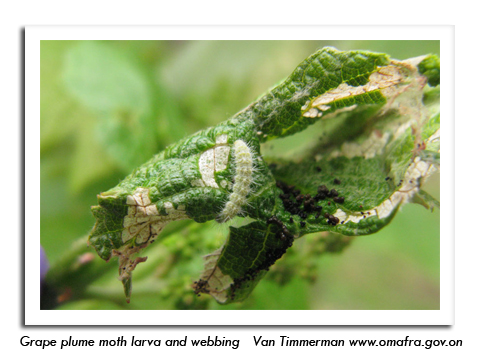
 |
|
|
Fruits
Volume 63 Number 5 Date 05/31/2018 CODLING MOTH - A significant increase in codling moth activity was charted in the last week. Counts ranged as high as 71 per trap and averaged 18 per trap. Seven of the 28 reporting orchards registered very high counts of 20 or more moths per trap. The spring biofix has now been set in most southern Wisconsin orchards and growers should make preparations to apply controls at 250-350 degree days (modified base 50°F) from their specific biofix date. The large moth numbers recorded this week suggest that a first larvicide application should be made at 250 degree days post-biofix, which could accumulate in as few as 10 days (early next week). John Aue of Threshold IPM Services advises growers using mating disruption (MD) to monitor traps just as diligently as other growers. There is evidence that the heavy flight is overwhelming the MD, at least in some orchards using less than the full, recommended rate of the MD product. At a minimum, growers are encouraged to monitor traps within known CM hotspots. SPOTTED TENTIFORM LEAFMINER - Moth counts were mostly low from May 24-30 and ranged no higher than 250 moths per trap. The average of 75 moths per trap is the lowest in several weeks and indicates that STLM populations are between the first and second flights. Numbers are expected to increase again by mid-June as the second flight starts. The economic threshold for STLM increases from 0.1 to one mine per leaf for the second generation of sapfeeder larvae. BROWN MARMORATED STINK BUG - An adult stink bug was collected in a Dane County pheromone trap last week, marking the earliest recorded first capture date in Wisconsin. The previous earliest report was on June 9, 2017. Apple growers planning to monitor BMSB this season should set their traps soon to monitor potential June activity. It should be noted that the overwintering generation of BMSB is not known to cause economic injury to apples and sprays are not advised before third cover. Cooperators are reminded that the clear sticky panel traps now supplied by DATCP are baited with both a BMSB lure and a green stink bug (GSB) lure. PLUM CURCULIO - Apple growers are advised to continue scouting fruits for crescent-shaped oviposition scars. Recent high temperatures may have caused the beetles to move beyond the perimeter trees, so scouting farther into orchard interiors will be necessary. Perimeter applications can be used as an alternative to full cover sprays if injury is limited to the border rows. However, a cover spray is recommended if signs of PC extend beyond the first 4-5 rows of trees. Another strategy is to leave untreated "trap rows" of early varieties that are treated with an insecticide (e.g. PyGanic) on a warm night when the weevils are most active. Organic options include PyGanic (pyrethrin) applied to the outer rows and Surround WP (kaolin) on the interior trees. GRAPE PLUME MOTH - Larvae are feeding on grape foliage and webbing together the terminal leaves of shoots in southern and western Wisconsin vineyards. The green caterpillars with whitish hairs commonly appear in late spring in perimeter rows near wooded areas. Their feeding on interveinal areas of leaves and characteristic webbing on young terminals is generally low-impact and control is usually not required. However, in exceptional cases when 20% of shoots show webbing or damage, spot treatment of infested rows with Bacillus thuringiensis var. kurstaki (Btk) may be considered. Since Bt must be ingested by larvae to be lethal, it is imperative to confirm the presence of caterpillars and treat only if the larvae are small enough that continued feeding is expected. Grape growers who notice shoots with young leaves webbed together are advised to unroll the leaf to verify that the larvae inside is grape plume moth. OBLIQUEBANDED LEAFROLLER - The spring flight continued for the second week, with low numbers of moths registered in scattered orchard locations. Late-instar larvae and rolled leaves are still evident at some sites. The recommended scouting procedure for OBLR is to begin checking terminals for small larvae 7-10 days after the first moths are captured. Although there is no direct correlation between trap counts and larval populations, scouting is important since orchards that register even low counts (< five moths per trap) can develop significant larval problems a few weeks after a flight has occurred. Control is warranted for populations averaging three or more larvae per tree. PLANT BUGS - Fruit growers can anticipate more plant bug adults appearing on apples, strawberries and other fruits as alfalfa harvesting accelerates in the coming week. Nymphs are abundant in alfalfa sweep net collections, and could contribute to problems in fruit crops next month. The economic threshold for this insect in strawberries is four per 20 sweeps. WOOLY APPLE APHID - Apple growers are advised to begin scouting areas infested with this aphid last season to confirm the first appearance of aerial colonies, expected to become noticeable by mid-June. -- Krista Hamilton, DATCP Entomologist 





|
|
|